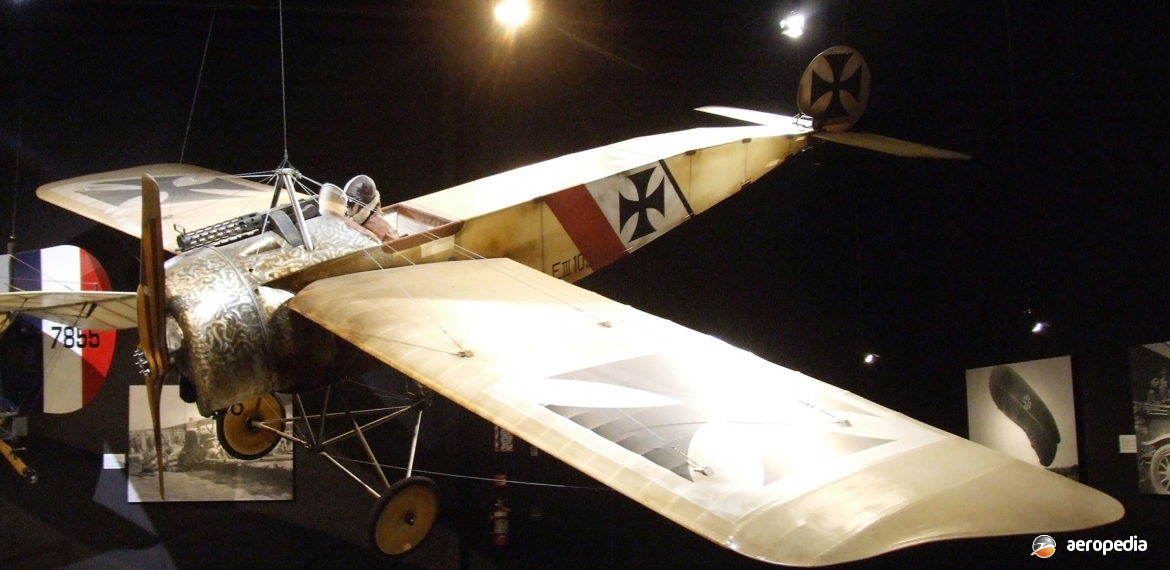Photograph:
Fokker E.III Eindecker serial 105-17 at the Omaka Heritage Centre, Blenheim, New Zealand in April 2011 (David C Eyre)
Country of origin:
Germany
Description:
Single-seat fighting scout
Power Plant:
One 75 kw (100 hp) Oberursel U.I nine-cylinder rotary air-cooled piston engine
Specifications:
- Wingspan: 9.52 m (31 ft 2¾ in)
- Length: 7.2 m (23 ft 7½ in)
- Height: 2.4 m (7 ft 10½ in)
- Wing area: 15.4 m² (165.77 sq ft)
- Max speed: 140 km/h (87 mph)
- Cruising speed: 120 km/h (74 mph)
- Service ceiling: 3,600 m (11,810 ft)
- Range: 240 km (149 miles)
- Empty weight: 399 kg (880 lb)
- Loaded weight: 610 kg (1,345 lb)
Armament:
One 7.92 mm (0.311 in) Spandau fixed machine gun firing forward
History:
The Fokker E.III Eindecker was a single-seat fighting scout produced by Fokker to meet the requirements of the German Air Force in World War I. The series commenced with an aircraft known as the M.14, which was developed to the M.5K, a training aircraft which had a longer fuselage and larger wing to permit ab initio training to be carried out.
The first of the M.5 series was flown in 1913 and from it was developed the M.5L with a longer-span wing, the M.5K having a shorter span wing. A small number were built and were operated by the Austro Hungarian Air Force. The M.5K was fitted with a Spandau machine gun and went into production as the E.I. A total of 68 Model E.Is was completed.
In order to develop the M.5 to fighter configuration some changes were made, including some reinforcement in a number of areas, the bracing pylon on the upper wing being strengthened, as was the undercarriage. Early production aircraft had the 60 kw (80 hp) Oberursel engine and in service became known as the Fokker E.I. It was these types which received the appellation “Fokker Scourge” in 1915 and had many successes against the RAF BE.2Cs of the Royal Flying Corps.
Development moved on to the Fokker E.II, and 12 examples were built. This was followed by an order for a further 47. Like the Fokker E.I, it was fitted with a DWM Parabellum MG.14 machine gun. In April 1915 a French-built Morane Saulnier type I aircraft was forced down behind German lines in France and captured after being damaged by ground fire. This aircraft had a system that had been devised whereby the single, fixed, forward-firing Hotchkiss machine gun fitted to the aircraft could fire through the propeller. Fokker engineers used the French design to build a synchronization system.
This system was the first device to be used that enabled the machine gun to fire in this manner, metal plates being fitted to the propeller to deflect those bullets which would otherwise have damaged the propeller. German development went on to a system whereby the aircraft had a mechanical interrupter, the rate of fire being adjusted to the rate of turn of the propeller, firing being interrupted as a blade passed in front of the machine gun. An LMG 08/15 machine gun could also be installed.
Three aircraft were delivered to service in July 1915, followed by a further 13 in the following month. Some were re-engined with the 75 kw (100 hp) Oberursel U.I engine, and new-build aircraft became known as the Fokker E.III. A total of 258 Fokker E.IIIs was completed, of which 221 were delivered to the Fliegertruppen, 19 to the Marine-Landflieger, 12 to the Austro-Hungarian Luftfahrttruppen, and six to the Austro Hungarian Navy.
Development continued to the Fokker E.IV, the prototype of which flew in November 1915. This model was fitted with a 119 kw (160 hp) two-row Oberursel rotary engine and had the wingspan increased to 10 m (32 ft 9⅔ in) which, although faster than the E.III, was not as manoeuvrable. Only about 40 were delivered. One was fitted with three machine guns and flown by German ace, Max Immelmann. Oswald Boelcke also flew the type.
One original example is known to have survived (serial 201/16). This machine was captured intact behind the British lines in France on 8 April 1916 when the inexperienced pilot became disoriented whilst flying in hazy conditions and landed at an airfield at St Omer. It has been held in the collection of the Science Museum in London, UK. One
One Fokker E.V (serial 140/18) was captured by Australian forces in Europe late in World War I and was taken to No 2 Aircraft Salvage Depot near London as a war prize, eventually to be shipped to Australia with other captured aircraft for a war mseum. However, it seems the cost of shipment of the approximately 70 captured aircraft to Australia was considered exorbitant and a cull was made of the aircraft to be shipped, with approximately 24 arriving and the rest being broken up. Only a few examples of enemy aircraft have survived and are dealt with elsewhere.
A few replicas have been built around the world and one of these was imported to join the growing collection of World War I aircraft at the Heritage Museum at Omaka, Blenheim, in New Zealand, this being a non-flying replica. A further two almost complete aircraft were built in Austria and these were imported to Masterton and Wellington, NZ for completion.
Another example has been completed at Caboolture, QLD by The Australian Vintage Aviation Society (TAVAS), this aircraft making its first flight on 5 May 2015 after having been placed on display at the Australian International Air Show at Avalon, VIC, in March, being registered with Recreational Aviation Australia (RAA) as 19-8593 (c/n 8). This aircraft has been finished in the markings of a machine flown in the Dardanelles by Hans-Joachim Buddecke during the Gallipoli campaign in 1914, where he scored four confirmed victories, achieving a total of 13 victories during World War I before being killed in combat with Sopwith Camels in France on 10 March 1918.

